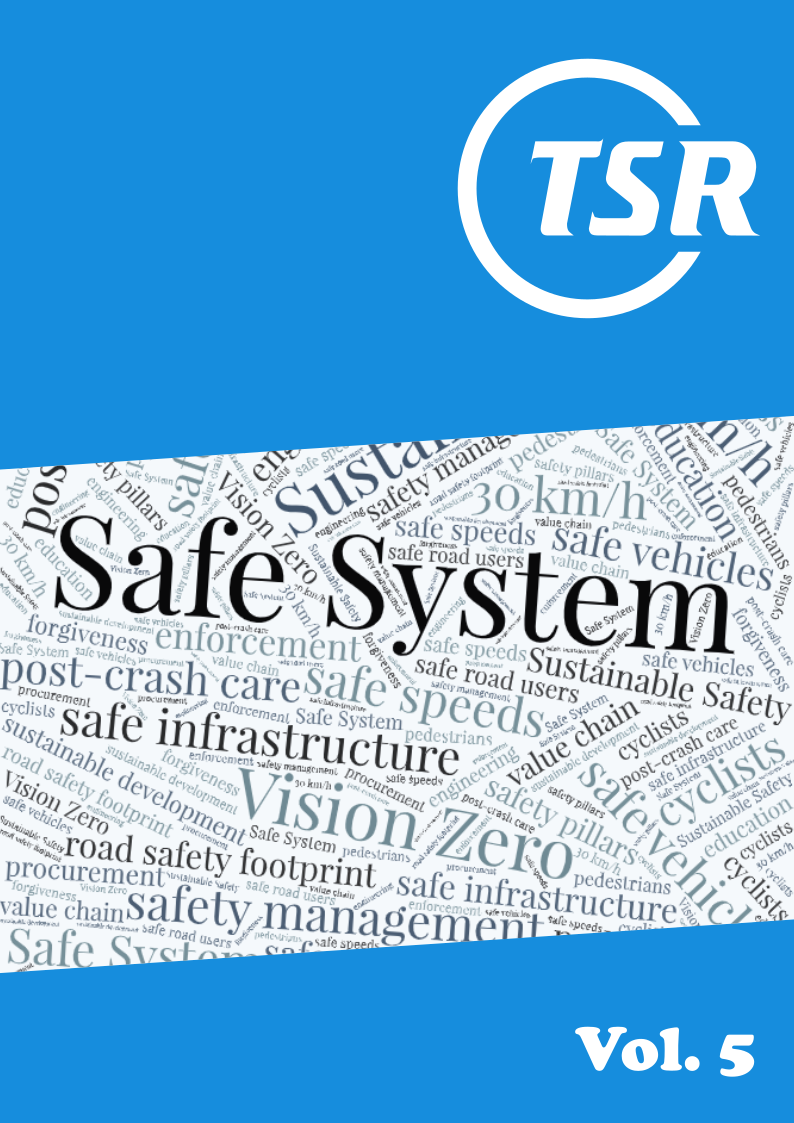Towards a safe system in low- and middle-income countries: vehicles that guide drivers on self-explaining roads
DOI:
https://doi.org/10.55329/avnw4364Keywords:
advanced driver assistance, low- and middle-income countries (LMICs), road safety, Safe System approach, self-explaining roadsAbstract
Road crashes cause a huge problem of public health in low- and middle-income countries (LMICs). The Safe System approach is generally considered as the leading concept on the way to road safety. Based on the fundamental premise that humans make mistakes, the overall traffic system should be ‘forgiving’. Sustainable safe road design is one of the key elements of the Safe System approach. Road design and speed control should help prevent crashes with a high level of kinetic energy. However, the road design principles behind the Safe System approach are certainly not leading in today’s infrastructure developments in most LMICs. Cities are getting larger with increasing motorization and expanding road networks. Existing through-roads in local communities are upgraded, resulting in heavy traffic loads and high speeds on places, that are absolutely not suited for this kind of traffic. Furthermore, a Safe System would require that functional design properties of vehicles and roads would be conceptually integrated, which is not the case at all. Although advanced driver assistance systems are on their way of development for quite a long period, their potential role in the Safe System concept is mostly unclear and at least strongly underexposed. The vision on future cars is dominated by the faraway concept of automation. This paper argues that the way to self-driving cars should take a route via the concept of guidance, i.e. vehicles that guide drivers, both on self-explaining roads and on more or less unsafe roads. Such an in-vehicle guidance system may help drivers to choose safe transport mode, a safe route and a safe speed, based on criteria related to safety and sustainability. It is suggested to develop driver assistance systems using relatively simple and cheap technologies, particularly for the purpose of use in LMICs. Such a guide may make roads self-explaining—not only by their physical design characteristics—but also by providing in-car guidance for drivers. In the future, the functional characteristics of both cars and roads may be conceptualized into one integrated Safe System, in which the user plays the central role. Such a guidance system may serve as the conceptual bridge between the roadway, the vehicle and the driver, and thus be considered as an indispensable component of the Safe System approach. It is argued that such a development is necessary to bring a breakthrough in road safety developments in LMICs and also give an acceleration towards zero fatalities in high-income countries.
Downloads
References
Bekiaris, E., E. Gaitanidou (2011), 'Towards Forgiving and Self-Explanatory Roads', in Bekiaris, E., M. Wiethoff, E. Gaitanidou (eds.), Infrastructure and Safety in a Collaborative World, (Berlin, Germany: Springer-Verlag). DOI: https://doi.org/10.1007/978-3-642-18372-0
Belin, M. A., Tillgren, E. Vedung (2012), 'Vision Zero - a Road Safety Policy Innovation', International Journal of Injury Control and Safety Promotion, 19(2), 171–179. DOI: https://doi.org/10.1080/17457300.2011.635213
Bhalla, K., K. Gleason (2020), 'Effects of vehicle design on road traffic deaths, injuries, and public health burden in the Latin American region: a modelling study', The Lancet Global Health, 8(6), E819–E828. DOI: https://doi.org/10.1016/S2214-109X(20)30102-9
Carsten, O., M. H. Martens (2019), 'How can humans understand their automated cars? HMI principles, problems and solutions', Cognition, Technology & Work, 21, 3–20. DOI: https://doi.org/10.1007/s10111-018-0484-0
Carsten, O. M. J., F. N. Tate (2005), 'Intelligent speed adaptation: accident savings and cost-benefit analysis', Accident Analysis & Prevention, 37(3), 407–416. DOI: https://doi.org/10.1016/j.aap.2004.02.007
ERSO, (2018), 'Advanced driver assistance systems', European Road Safety Observatory.
EuroRAP, (2015), 'Road that cars can read', European Road Assessment Programme.
FIA, (2020), 'Promoting Safer and Cleaner Used Vehicles for Africa', Federation Internationale de l'Automobile Region I.
Godthelp, J. (1990), 'Towards control in road traffic [in Dutch]', Verkeerskunde, 41(3).
Godthelp, J., F. Op De Beek (1991), 'Driving with GIDS: Behavioural Interaction with the GIDS Architecture', Advanced telematics in road transport: DRIVE conference, Brussels, Belgium, 4–6 February 1991.
Gururaj, G., G. M. Sukumar (2017), 'Advancing road safety in India: Implementation is the key', National Institute of Mental Health & Neuro Sciences.
Hydén, C. (2020), 'Speed in a high speed society', International Journal of Injury Control and Safety Promotion, 27, 44–50. DOI: https://doi.org/10.1080/17457300.2019.1680566
Kulmala, R. (2010), 'Ex-ante assessment of the safety effects of intelligent transport systems', Accident Analysis & Prevention, 42(4), 1359–1369. DOI: https://doi.org/10.1016/j.aap.2010.03.001
Makwasha, T., B. Turner (2014), 'Evaluating vehicle activated signs at rural roads', 26th Australian Road Research Board Conference, Sydney, Austratlia, 19–22 October 2014.
Michelin, (2014), 'Road safety and connected mobility: An overview report on the current status and implications of road safety and connected mobility', Michelin Challenge Bibendum.
Michon, J. A. (1985), 'A critical view of driver behavior models: what do we know, what should we do?', in Evans L., R. C. Schwing (eds.), Human behavior and traffic safety, (New York, USA: Plenum press). DOI: https://doi.org/10.1007/978-1-4613-2173-6_19
Michon, J. A. (1993), Generic intelligent driver support, (London, UK: Taylor & Francis).
Ministerial Conference, (2020), 'Stockholm Declaration', 3rd Global Ministerial Conference on Road Safety, Stockholm, Sweden, 19–20 February 2020.
PWC, (2019), 'The future of mobility', Price Cooper Waterhouse.
SAE, (2018), 'Taxonomy and Definitions for Terms Related to Driving Automation Systems for On-Road Motor Vehicles', SAE International.
SWOV, (2022), 'Road deaths in the Netherlands', SWOV, Institute for Road Safety Research.
SWOV, (2006), 'Advancing Sustainable Safety: National Road Safety Outlook for 2005-2020', SWOV Institute for Road Safety Research (Leidschendam, the Netherlands).
Theeuwes, J. (2021), 'Self-explaining roads: What does visual cognition tell us about designing safer roads', Cognitive Research: Principles and Implications, 6. DOI: https://doi.org/10.1186/s41235-021-00281-6
Theeuwes, J., J. Godthelp (1995), 'Self-explaining roads', Safety Science, 19(2–3), 217–225. DOI: https://doi.org/10.1016/0925-7535(94)00022-U
Tinga, A. M., I. M. van Zeumeren, M. Christoph, E. van Grondelle, D. Cleij, A. Aldea, N. van Nes (2023), 'Development and evaluation of a human machine interface to support mode awareness in different automated driving modes', Transportation Research Part F: Traffic Psychology and Behaviour, 92, 238–254. DOI: https://doi.org/10.1016/j.trf.2022.10.023
UN, (n/d), 'Sustainable Development Goals', United Nations.
UN, (2020), 'Improving global road safety', United Nations, General Assembly.
UNEP, (2020), 'Used Vehicles and the Environment: A Global Overview of Used Light Duty Vehicles - Flow, Scale and Regulation', United Nations Environment Programme.
Vaa, T., T. Assum, R. Elvik (2014), 'Driver support systems: Estimating road safety effects at varying levels of implementation', Institute of Transport Economics (Oslo, Norway).
van Geem, C., S. Charman, A. Ahern, A. Anund, L. Sjögren, A. Pumberger, G. Grayson, S Helman (2013), 'Speed Adaptation Control by Self Explaining Roads (SPACE)', 16th Road Safety on Four Continents Conference, Beijing, China, 15–17 May 2013.
Welle, N., A. B. Sharpin, C. Adriazola-Steil, S. Job, M. Shotten, D. Bose, A. Bhatt, S. Alveano, M. Obelheiro, T. Imamoglu (2018), 'Sustainable & Safe: a Vision and Guidance for Zero Road Deaths', World Resources Institute.
WHO, (2010), 'Decade of Action for Road Safety', World Health Organization.
WHO, (2015), Second Global High-level Conference on Road Safety: Time for Results, Brasilia, Brasil, 18—19 November 2015.
WHO, (2018), 'Global status report on road safety', World Health Organization (Geneva, Switzerland).
Wilmink, I., W. Janssen, E. Jonkers, K. Malone, M. V. Noort, G. Klunder, P. Rämä, N. Sihvola, R. Kulmala, A. Schirokoff, G. Lind, T. Benz, H. Peters, S. Schönebeck (2008), 'Impact assessment of intelligent vehicle safety systems', eIMPACT, Deliverable D4.
Published
How to Cite
Issue
Section
License
Copyright (c) 2023 Hans Godthelp

This work is licensed under a Creative Commons Attribution 4.0 International License.








